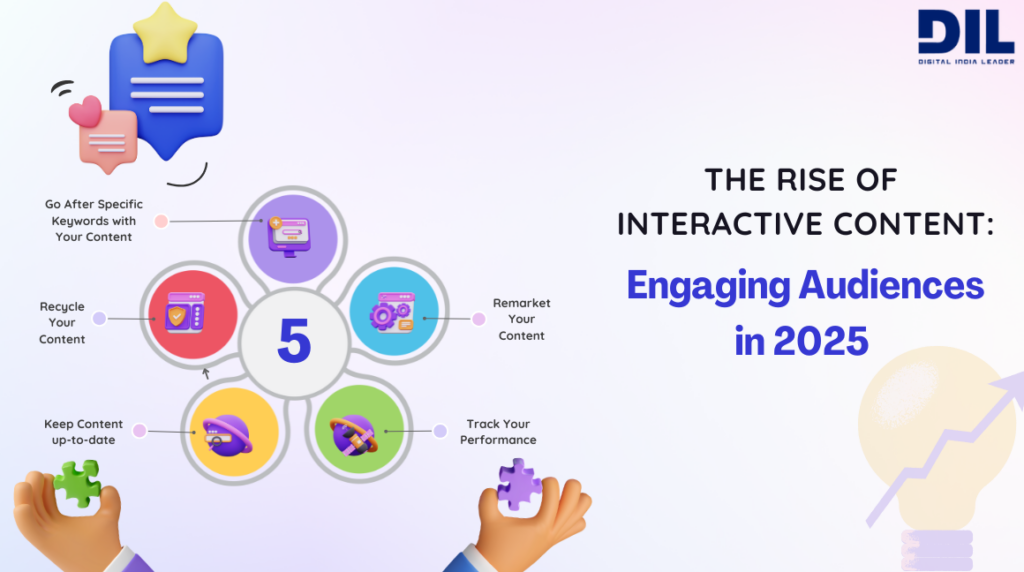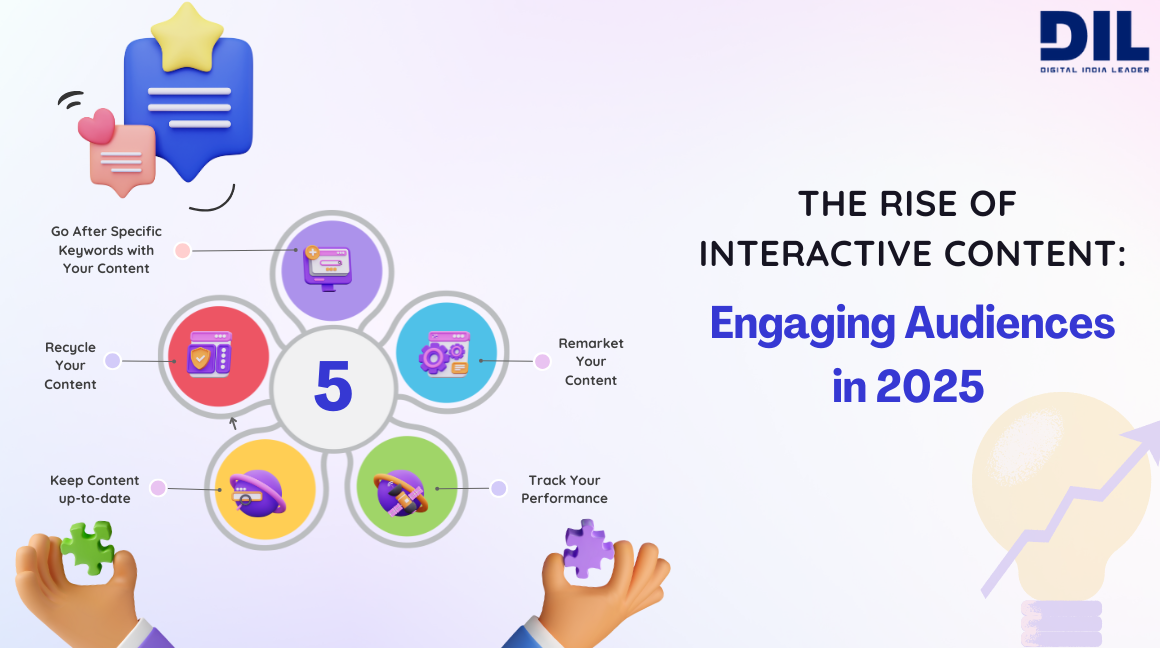
Introduction: The Growing Importance of Interactive Content
The digital landscape is constantly changing, and businesses must adapt to keep up with the latest trends. As traditional content becomes less effective in capturing attention, interactive content is emerging as a powerful solution to engage users. In 2025, it is expected that interactive content will dominate the online space, reshaping the way we consume and interact with digital media.
What is Interactive Content?
Definition and Examples
Interactive content refers to any type of content that requires active participation from the user. Unlike traditional passive content like articles or videos, interactive content encourages users to engage directly with it. Examples include quizzes, polls, interactive videos, games, and calculators.
How Interactive Content Differs from Traditional Content
Traditional content is one-way communication – you create the content, and the audience consumes it. Interactive content, on the other hand, invites the audience to play a role in the content experience. This shift from passive to active engagement makes it more appealing to modern consumers who crave personalization and involvement.
The Psychology Behind Interactive Content
Why Engagement Matters
Psychologically, people are more likely to remember content they actively engage with. Interactive content creates a sense of involvement, leading to better retention and a stronger connection with the brand. Studies show that when users engage with content, they feel more valued, which can result in increased trust and loyalty.
The Power of Personalization
Personalization plays a crucial role in interactive content. By offering tailored experiences, brands can speak directly to individual preferences and needs. For example, a quiz that suggests a product based on a user’s answers is far more engaging than a generic ad.
Types of Interactive Content
Quizzes and Polls
Quizzes and polls are among the most popular types of interactive content. They offer a fun and easy way for users to engage while providing valuable insights for brands. Quizzes can be used to educate users, recommend products, or collect feedback.
Interactive Videos
Interactive videos are an exciting innovation in digital marketing. Viewers can make choices during the video, such as selecting different paths in a story or clicking on hotspots to learn more. This type of content offers an immersive experience and allows users to control the narrative.
Interactive Infographics
Infographics are a great way to present complex information in a visual format. Interactive infographics take this a step further by allowing users to click on elements to explore data, reveal hidden information, or navigate through different sections.
Calculators and Assessments
Interactive calculators and assessments provide users with personalized results based on their inputs. These tools can be particularly useful in industries like finance, health, and e-commerce, where customers often need guidance to make informed decisions.
Games and Gamified Content
Gamification has become a popular trend in content marketing. By incorporating game-like elements such as rewards, points, or challenges, brands can make their content more engaging and fun, which keeps users coming back for more.
Chatbots and Conversational Marketing
Chatbots are revolutionizing customer service and marketing by offering real-time interaction. These AI-powered tools can engage users in conversations, answer questions, and guide them through the buying process, providing a personalized experience.
The Rise of Interactive Content in 2025
The Technological Advancements Driving Interactive Content
In 2025, we expect to see even more advanced technologies driving the rise of interactive content. Virtual reality (VR), augmented reality (AR), and AI are transforming how we create and consume content, making experiences more immersive and personalized.
Integration with AI and Machine Learning
AI and machine learning will play a crucial role in making interactive content more intuitive and responsive. With advanced algorithms, brands can predict user behavior and tailor content in real-time, offering a truly personalized experience.
The Benefits of Interactive Content
Increased Engagement
Interactive content has been proven to increase user engagement. The more engaged users are, the more likely they are to spend time on your website, share your content, and take action – whether it’s making a purchase, subscribing to a newsletter, or following your brand on social media.
Higher Conversion Rates
Studies show that interactive content generates higher conversion rates than traditional content. By offering personalized experiences, you can guide users through their decision-making process, making them more likely to convert.
Enhanced User Experience
Interactive content enhances the overall user experience by providing entertainment, education, and value. This creates a more memorable encounter with your brand, leading to better customer satisfaction and loyalty.
How to Create Interactive Content
Key Steps to Get Started
To create effective interactive content, start by defining your goals. Whether you’re aiming to increase brand awareness, generate leads, or educate your audience, your interactive content should align with your objectives. Next, choose the type of content that best suits your audience and message, and ensure it’s easy to navigate.
Tools and Platforms for Interactive Content
There are various platforms available that allow you to create interactive content, including Typeform (for quizzes and surveys), Involve.me (for interactive landing pages), and Playbuzz (for gamified content). Explore these tools to streamline your content creation process.
Measuring the Success of Interactive Content
Metrics to Track
To evaluate the success of your interactive content, track metrics such as engagement rate, time spent on page, conversion rate, and bounce rate. These metrics will help you understand how well your content is performing and where improvements are needed.
How to Optimize for Better Results
Optimizing your interactive content involves testing and iterating based on user feedback and performance data. A/B testing different formats, questions, and calls-to-action can help you identify the most effective strategies for your audience.
Challenges of Interactive Content
Resource and Time Intensive
While interactive content can be highly effective, it can also be resource and time-intensive to create. It requires a thoughtful approach, specialized tools, and sometimes, technical expertise.
Balancing Creativity with Functionality
The key challenge in creating interactive content is striking the right balance between creativity and functionality. While it’s essential to create engaging experiences, the content must also serve its purpose and deliver value to the user.
The Future of Interactive Content
Trends to Watch for in 2025 and Beyond
As technology continues to evolve, so will the types of interactive content available. Expect to see even more personalized experiences, the integration of AI in real-time interactions, and the growth of immersive technologies like VR and AR.
Predictions for the Next Decade
In the next decade, interactive content is likely to become even more integrated into our daily digital lives. The lines between content consumption and interactive experiences will blur, with immersive environments becoming the norm in marketing and online interaction.
Conclusion
Interactive content is not just a passing trend; it’s the future of digital engagement. As we approach 2025, its role in building stronger connections with audiences will only grow. By embracing this interactive shift, businesses can foster greater engagement, boost conversions, and create more personalized experiences for their customers.
FAQs
1. What are some examples of interactive content?
Interactive content includes quizzes, polls, interactive videos, infographics, calculators, games, and chatbots.
2. How does interactive content improve user engagement?
Interactive content encourages users to participate, making them feel more involved and valued, which increases engagement and retention.
3. What are the benefits of using interactive content for businesses?
Interactive content leads to higher engagement, better conversion rates, and a more enhanced user experience, resulting in stronger brand loyalty.
4. How can I create interactive content for my business?
Start by defining your goals, choose the right type of content, and use tools like Typeform, Involve.me, or Playbuzz to create and manage your content.
5. Is interactive content effective for all industries?
Yes, interactive content can be tailored to suit any industry, whether it’s e-commerce, education, health, or entertainment.





